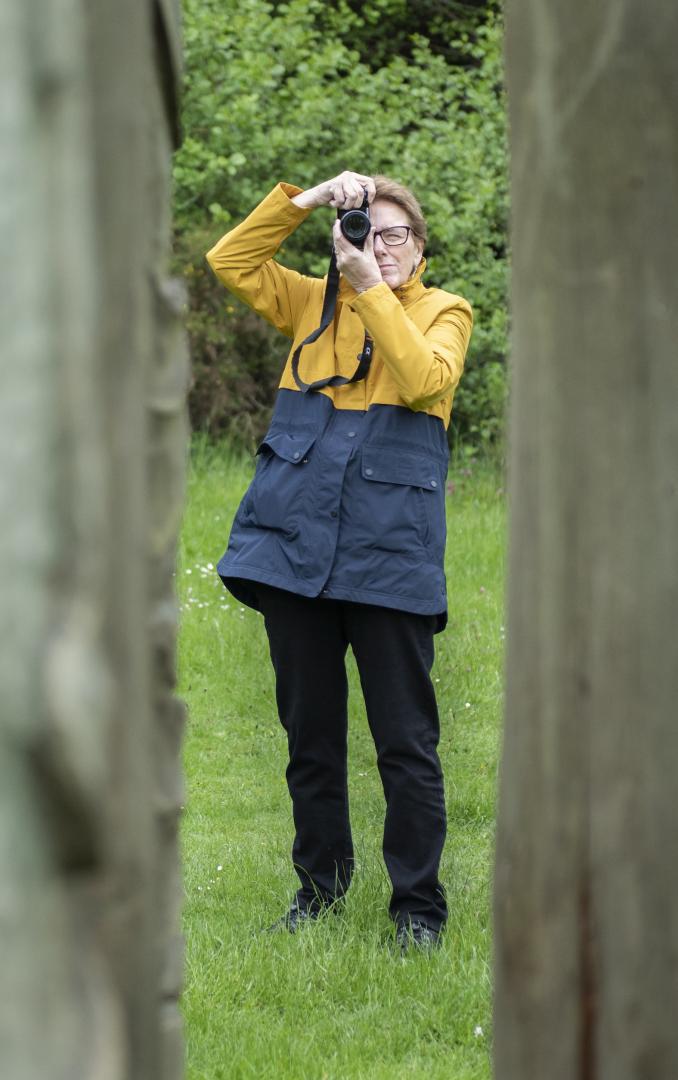For the last two years photographer Elaine Vizor from Spring Gardens has been helping catalogue public statues as part of a nationwide project. During lockdown her voluntary photography work with Art UK has been curtailed but this has not stopped her exploring new and old photographic techniques
How did you get started as a photographer?
I’ve always had an interest in photography since my first Kodak Brownie film camera as a young teen. I got my first SLR 35mm film camera at college later when not many people had them and studied black and white photography as an extra subject at teacher training college.
Unfortunately, the rigors of a demanding career and family meant photography was put aside until 2008 when I felt compelled to pick it up again seriously.
I thought I needed to be brought up to date and so started to learn digital photography at night classes.
I continued to study until achieving a master of arts in photography at the University of Sunderland. After this I worked as a part time teacher and freelance photographer. Until Covid-19 I was developing workshops in basic digital photography, cyanotype printing, taking commissions and working on my own design for a portable Camera Obscura, which I hope to complete in time.
What kind of photography do you find most appealing?
I have an eclectic taste when it comes to photographic genres but I find myself most absorbed by documentary photography.
I love to photograph processes that are eventually hidden – the photographic record keeps it alive, tells the story again.
I particularly enjoy photographing in factories and have many favourite photographs from visits to Aycliffe Fabrications, Halley Stevensons, in Dundee, and Barbour, in South Shields.
Documentary photography records factual happenings and creates a timeline of events. It is also very creative and can combine portraiture and abstractions within a process.
I like abstract photography and creating images that blur the perceived line between art and photography which sometimes involves breaking the rules of photography creatively.
Some wildlife photographers will camp out for days and weeks on end to get the ultimate photograph of animals in their natural habitat. What lengths have you gone to get your perfect shot?
On the subject of wildlife, an unplanned and unexpected photo opportunity presented itself to me in Spring Gardens Wetlands when I almost stood on a pile of toads that looked like mud.
I was intrigued by the sight of piggybacking toads and decided to photograph them. Shots from above were not pleasing so I figured I needed to view from the level of the toads. I only had my iPhone with me so proceeded to get down to the level of the toads to get a close up shot. For this I had to lie out flat on the ground and position my iPhone as close as possible to the tower of toads. Sometimes you have to be prepared to get down and dirty to gain a better shot.
I titled my image ‘Three Tier Toad Taxi’ as I thought it fitted with the lazy toad phrase but subsequently I was informed that toads mate this way too. Whilst maybe not a subject of choice, I was very pleased with the result.
I think patience is essential with any wildlife photography and a sense of anticipation and hope.
Each spring I spend time photographing damselflies locally. This involves taking time and some near misses when getting too close to the edge of the pond but it’s worth the time and the effort. It’s also a great way to learn for the old and young alike.
I now take my granddaughter with me. She is great at spotting the damselflies deep in the reeds and we take photos of the stages in the damselfly reproductive cycle. It is fascinating. We love the heart shaped mating wheel.
I suppose, my love of public art has driven me to the greatest literal length to obtain a photograph. After viewing Anish Kapoor’s Temenos in Middlesbrough and researching into artworks I had an ambition to photograph his Cloudgate (AKA The Bean). I wanted to see the giant mirrored steel sculpture for myself. This necessitated flying to Chicago which I did for a big birthday treat 2016. It was wonderful. I took many photos all round The Bean. A bit like the Angel of the North, it was difficult to get a photo without other people in it but as it happened, Chicago Cubs won the baseball World Series when we were there and The Bean was cordoned off to protect it from the thronging crowds. This gave me the opportunity to view it virtually undistracted.
Do you have a preferred camera?
I have a range of cameras including my very first film cameras, my Digital SLR cameras, my now preferred Sony mirrorless cameras and, of course, I have an iPhone.
My first photography was using film. This was the only photography I knew and it seemed a lot easier to grasp than digital photography or at least the complicated menus involved in digital cameras.
Some would say film photographs have a finer quality or texture not matched by digital, most would say that digital is much better by far. I would say, each to their own.
It’s fun to use film and good to experiment but most people will use digital cameras and there are so many additional tools to use to enhance images.
Young people embrace the technology readily so I’d say go with it and enjoy it. In my digital photography workshops we look at making rather than just taking images and think about principals such as composition, perspective and creative blur.
I’d say enjoy all the benefits and enhancements of phone and digital camera photography but if you can, try out old school photography, you’ll get an idea of where it all started and experience what it was to take time to take a photograph, have limited shots and then have to wait days to see how you did. It’s incomprehensible now. Digital has to be better!
What projects have you been keeping yourself busy with during 2020 and the various lockdowns?
At the start of the first lockdown I decided to not use a camera but only the vintage form of Cyanotype Printing to produce my creative response to coronavirus.
This process is actually vintage photography and precedes the use of what we understand as cameras.
The cyanotype process, discovered in 1842, used chemicals sensitive to sunlight to produce contact images on a surface. The blueprint process was used by the first photographer, Anna Atkins, from 1843, to create botanical images (photograms) which she catalogued in the first ever photobooks, all without a mechanical camera.
My personal challenge was to create pictures in response to the news using chemicals, paper and fabrics, sunlight and objects I had to hand already or could save from recycling for this purpose.
My first project, Twelve Weeks, aimed to produce one picture for each week. I produced many more and used various household objects to represent the virus imagery and my experience of the crisis. A young friend joined me on the challenge and he produced 12 different artworks in response to the crisis.
Over the summer months I kept myself creatively busy by supporting my grand-daughter to complete her first Art Award with MIMA (Middlesbrough Institute of Modern Art). This also introduced us to MIMAZINA, MIMA’s online magazine and we have both contributed to the magazine over the months. We also enjoyed an animated walk with local artist Sheryl Jenkins and learned new skills. I’ve also supported other local art initiatives and encouraged family and friends to submit creative works to online exhibitions.
I also entered my Art UK photographs of David Mach’s TRAIN as an iMovie in Darlington Wonders, an exhibition that sadly had to close as soon as it opened.
As a member of the Barnard Castle and Teesdale Art Society I started to go outside to sketch with others in the summer months but then with one friend only when we were restricted further.
Do you have a favourite photo that you have produced?
My favourite photograph has to be EH4 from my final MA show entitled Now You See Me. It’s a portrait of my college friend. The series was a celebration of women over 50 but this image for me also represents lasting friendship and favourite views. The icing on the cake was it being exhibited in the National Portrait Gallery, London, 2014-2015.
A close contender for my favourite work is Head and Shoulders Above, from Changes, my documentary on the making of Joseph Hillier’s In Our Image (County Durham’s tallest sculpture). This image was exhibited in the Houses of Parliament, December 2016. I was very pleased that the work of Aycliffe Fabrications who made it in County Durham was showcased in this way.
Have you found inspiration from other photographers?
In the course of my studies I have discovered and been inspired by many artists and photographers such as Henri Cartier-Bresson, the first real street photographer who gave us “the decisive moment” and also women photographers including Reneke Dykstra, a Dutch master of deadpan portraits, and Valentina Bonizzo, an Edinburgh based Italian photographer, both of whom influenced the photographic techniques I adopted, adapted and applied in Now You See Me. But my greatest inspiration is still my friend Jan Wilson.
Since 2008 we’ve had many photography outings to the regions hidden places and large scale artworks and as we both share a great passion for photography we could really indulge ourselves in taking endless photographs and spend hours viewing and discussing them afterwards.
For anyone who hasn’t seen your photography, is there anywhere currently they can view it?
Examples of my work are on permanent display at Aycliffe Fabrications, where Christine Bewley converted the factory foyer into a gallery dedicated to my work documenting the process of manufacturing In Our Image.
Visitors are welcomed to view them by appointment (Aycliffe Fabrications 01325 310000). My photographs documenting the journey through Weardale and the making of the Weardale Tub can be seen at Killhope Lead Mining Museum on two large interpretation panels behind the impressive artwork housed at the Museum.
I have another solo exhibition planned at Greenfield Arts from 15 September 2021. Covid-19 restrictions permitting, visitors are encouraged to come along. I can be contacted via my Instagram account: vizorelaine or visit www.facebook.com/elainevizorphotography










